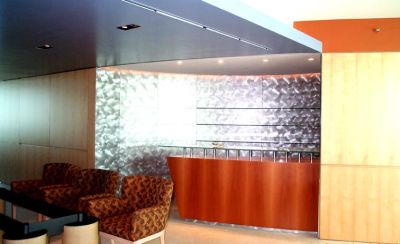Choosing Metal Laminates
Metal laminate products and their appropriate uses. August 30, 2005
Question
I am looking for a metal laminate (preferably a matte aluminum) without the phenolic backer. I want to avoid the black line entirely and have enough material thickness that I can put a nice bevel on it. I would also be open to using an actual sheet of metal as long as normal shop tools will work with it. Can anyone recommend a company (I need metal edges for the doors as well) that makes a large selection of this kind of laminate? This project is for a customer who wants me to match a Poggenpohl (a high-end European kitchen manufacturer) kitchen that uses an aluminum laminate.
Forum Responses
(Laminate and Solid Surface Forum)
From contributor M:
Wilsonart and Formica both have a metal (aluminum) line that has no phenolic. The material is aluminum all the way through and comes in a variety of finishes and colors. It can be easily machined and worked with using traditional woodworking/laminate tools. However, they will cause tools to go dull much quicker than traditional materials. I caution you - these aluminums are very, very soft. They scratch and ding very easily. Almost scratch just from handling them. Your client may be unhappy with the appearance of their kitchen just a short time after it has been installed, as these materials do not wear well.
From contributor R:
I agree with the post above, and I work for Wilsonart. Our Decorative Metals are not intended for horizontal applications. They work great vertically, as in a backsplash. The kitchen in my office has an AlumaSteel backsplash. It looks like stainless steel, but machines similar to plastic laminate. It looks great after two years and does fingerprint like real stainless.
We make a laminate collection called MetalFX. They look pretty good, although they're not metal. They do perform like standard laminate as far as surface characteristics go. To get rid of the brown line on a counter, you could apply a bevel Custom Edge. We make those as well.
Edging on a door can be the anodized aluminums. They're not exposed to the same wear and tear as a horizontal surface. If you're laminating the face of a door, you can use the MetalFX. Laminate the edges first. The face will cover the line.
From contributor M:
I think we both agree that the Decometals are not intended for horizontal applications. I would have to caution that they be used sparingly on vertical applications, also. Backsplash, sure go ahead and use it. But base cabinet vertical surfaces? No way. They still encounter too much wear and tear. I realize you did not suggest the Decometal for vertical surfaces. You suggested the MetalFX (which I am not familiar with) - I just want to be sure that the recommendations are clearly understood.
I have been a long-time user and supporter of Wilsonart. Unfortunately, as beautiful and cool looking as the Decometals are, I refuse to use them anywhere other than areas that will never get any exposure to potential wear.
From contributor T:
You might want to try the real thing - stainless steel - for its superior surface durability. It can be had in sheets of 1/16" th. Also, Outwater have a large selection of metal sheets. The brushed metal hides surfaces scratches better.
From contributor G:
We had a customer that wanted stainless (real) used as edging for the countertops and a few doors. What a bear to work with! Hopefully never again!
From contributor M:
I don't care if it is only 1/32" thick - real stainless steel is an absolute bear to work with. It will require metal working tools, not plastic laminate and woodworking tools. Do not even attempt to mess with real stainless steel. It's a lot of money to spend to find out that you can't do anything with it.
Also, the metals from Outwater are the same as the Wilsonart and Formica Decometals. They are aluminum and very soft. Of course, brushed aluminum will hide scratches better, say, than a matte or polished. But even in the brushed aluminum, a scratch still looks like a scratch.
From contributor R:
MetalFX are part of the Standards Collection. If you have wallboard, they're on there. Somewhere on the right side of the board, they're grouped together. There is metallic ink used in the printing of the decorative paper and then it's pressed into standard laminate. They are on our standard chains as well. It is fair to note that they carry a premium due to the special ink and the 7-finish.
From contributor T:
Fortunately, there are a couple of metal shops nearby that produce exceptional work. It is correct that it takes a professional shop to achieve good results.

